MARY SIBANDE: dressed to tell South Africa’s tale
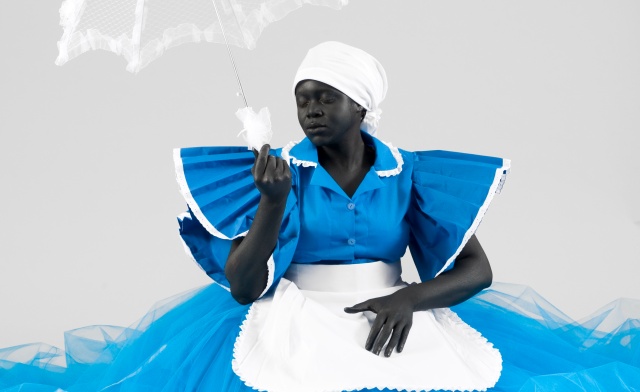
Mary Sibande is one of South Africa’s most talented young artists. For several years, her work has nearly exclusively revolved around Sophie, a servant character created from her personal genealogy (her mother, grandmother and great-grandmother were maids). Sophie’s dark silky skin and her majestic eye-catching blue Victorian dresses turn her into a queen whose eyes close on reality (but only a little, as only artists can do) to open on a world of celebrational fantasy exploring South Africa’s identity. Mary Sibande is not only a fine storyteller, she also embodies the African woman of our times: assertive, articulate, artistically ambitious and engaged in a life bursting with energy and desire for reinforcing democracy and equality in her country. A go-getter. We met in Helsinki on the occasion of the must-see exhibition Ars11 at Kiasma and in Venice at the inauguration of the South African pavilion.
– Dressing Sophie is a very long process (from conception to performance/installation/photography) that is also challenging from a technical point of view as you transform a maid’s dress into a gigantic Victorian one… Are you Sophie’s fashion designer?
– When I was in high school, I wanted to be a fashion designer – every girl wants to be a fashion designer! – but I did not manage to enter the Fashion school because of a deadline issue. I settled on Fine Arts and do not regret it but I felt the need to return to my first love which is fashion. I somehow tied in the fashion world and the Fine Arts world.
The reason why Sophie’s dresses are big is because I was interested in the Victorian era. When you look at images of Victorian dresses, you realize that women found it hard to wear such big, heavy and tightened-up dresses and that their movements were limited as a consequence. I constructed Sophie’s clothing with that “limited movement” concept in mind. Sophie goes to work in her ordinary dress. If she were wearing such big and heavy Victorian dress, she wouldn’t be able to do anything. Her dress is a protest against being a maid and at the same time it is the facade that allows her fantasies to come to life.
As for the technical side of sewing the dresses, I have now a very talented assistant to help me make them… cutting them and then being in front of the sewing machine was too much… I would go crazy if I had to do them all by myself! I am also assisted by a great make-up artist and a talented photographer.
– Who/what came first, Sophie or the dress?
– I think it was Sophie first and I had later to dress her. Sophie relates to my childhood. I once said that I grew up poor but I had everything that I needed. As a typical young girl, I had dolls and I made clothes for my dolls. It feels like I am doing the same thing now at giant scale to life-size dolls.
– Why Sophie?
– My work is influenced by the women in my family who were all maids. My grandmother told me the story of my great-grandmother who had two African names but her masters couldn’t remember them. So they gave her a Christian name: they called her Elsie. I took this story.
– Yinka Shonibare uses African textiles to stage traditional Victorian scenes in order to denounce colonialism and post-colonialism… has he influenced your work?
I like his work a lot: how he uses textile, how he designs the dresses and how he questions the Victorian era. We are related by our use of textiles but I work with different fabrics.
Mine are inspired by the Zionist churches in South Africa (author’s note: a mixture of Western religion and African belief in ancestors): I used their distinctive blue fabrics for the dresses but took a different pattern. I like them: they call themselves the “Soldiers of God” and you should see them when they go to church – they put on their starchy clothes… That’s fashion! Why do you need a garment to go to church? That’s also my next venue, actually, I have already started: I venture into religion and uniform and textiles and the link in-between. That’s how I constructed Sophie.
– During the FIFA World Championship, giant posters of your “Sophie” work covered Johannesburg walls. How were these images perceived? Did your message of celebration and getting over the post-colonial past go through?
– The advertisement agency “Art at work” got this idea to exhibit Sophie photo’s without any text, pure visuals on the walls of Johannesburg (author’s note: on the walls of 19 buildings in Johannesburg within the frame of a project called “Joburg Art City”). The project went on for six months in most of the spaces. Initially, people thought of the campaign in terms of “what does it sell”? Eventually, I got a five minutes interview on a local TV and explained the story of my character. The interview started to run in loops and people made the connection between what they saw in the city and what they saw on TV.
– Your character Sophie also tells the story of the evolution of the position of the black woman in the South African society…
– A lot of people got the idea that Sophie is a strong woman… My work is not about complaining about apartheid, or an invitation to feel sorry for me because I am black and my mothers were maids. It is about celebrating what we are as women in South Africa today and for us to celebrate, we need to go back, to see what are we are celebrating. To celebrate, I needed to bring this maid.
There is a lot of Western influence in the definition of today’s South African women: they are “vuka uzenzele” meaning wake-up and do-it-yourself type of persons, go-getters. We are a young democracy, we are the “born free’s”. In my generation, a lot of women get an education and they are career- focused. For example, I am twenty-nine now and I am building my life. By comparison, my mother had me when she was twenty.
I ’m really proud of being South African today – we all are. My ancestors might have had it hard during the apartheid era because they were “double colonized” – because of their colour AND their gender. Now lots of companies empower women and many women are CEO’s, we have a woman vice president… RSA is generating its own inspirational female model starting from the fact that the only heroes we have are our mothers that worked as maids. Higher education for black people used to be restricted to becoming a nurse or teacher, it’s changed now. Besides, there was an architecture of apartheid that was designed for people to rely on the white men for everything. From that point of view things have changed too and one does not ask the white men for a job anymore, that’s simply not the mentality anymore.
– My reality-check of your assertion on the improvement of gender equality is quite personal: does your boyfriend easily accept your success?
– My boyfriend is a very successful artist himself: he has won numerous awards, and for two years now he has been a teacher. He is hungry for that dream I am hungry for. There is no ego in the house because ego’s can break love and we love each other. Maybe to get a new drive, I’ll go away to teach and then come back again, as he does. It is nice to move away sometimes, nice to move away from the centre of the scene.
– What about artists communities in South Africa? One could easily imagine there is an effervescent artistic life over there… but is it sustainable to be an artist in South Africa and do artists have a voice?
– Artists are recognized as artists: there is a stage, there is a voice for artists to do whatever they want to do. There are many foreigners – mainly Germans – joining us. However, there is a difference between South African and German artists: if you want to be an artist in South Africa, you have to sustain yourself, the state will not help. For example, as already mentioned, my boyfriend is sustaining his art by working as a teacher.
– After your exhibition in Helsinki (Ars11 at Kiasma), your next big event is your official participation in the Venice Biennale (South African pavilion).
I am presenting an extension on my work about Sophie and I am moving away from her slowly. I am introducing an absent masculine. It’s an autobiography… my father will be Sophie, he will have breasts. My parents separated when I was two years old and I was surrounded by my mother’s side of the family. How to include him, how to introduce him? He is in the army so I worked on developing an army of Sophie’s… (silence) I am a storyteller above all.
– You also have a couple of prestigious artist residencies ahead of you. How do they nurture your work?
I have a residence at the Ranieri foundation and a Smithsonian fellowship. During my residencies, I gather information about RSA and look at the country from another angle. My show at Momo Gallery was conceived in NY where I had every possibility to gather the material and info I needed about RSA. Back home, I start working.
Ars 11 at Kiasma (Helsinki) and the Venice Biennale concomitantly close their doors on Mary’s work. Sophie is still alive but in Venice soldiers are pointing with imaginary arms at her (“Lovers in Tango”), she is a sooner or later called to die Queen bee wearing a beehive like dress (“..and Prosperity”)… little signs that Sophie is approaching her end… What will come next? Mary Sibande has surely many more stories to tell…
* This interview has been edited – author: Ruxandra Balboa-Pöysti – reviewer: Diana Kaley
________________________________________________________
TO KNOW MORE ABOUT MARY SIBANDE’S WORK
Gallery Momo: http://www.momogallery.com
Another interview: http://corrigall.blogspot.com/2010/07/interview-with-mary-sibande.html
Joburg Art City: http://www.artatwork.co.za/ and more specifically: http://www.artatwork.co.za/web/experience/special-projects/item/128-joburg-art-city-with-mary-sibande-and-the-dead-queen
Her influences: http://www.yinkashonibarembe.com/
Her current events: http://www.labiennale.org/en/art/exhibition/first-time/south-africa.html
Filed under contemporary art, culture, exhibitions, fashion · Tagged with AAW, and Prosperity, apartheid, Art at Work, artist interview, artist residency, arts, black women, Caught in the rapture, FIFA 2010, Her Majesty Queen Sophie, I decline. I refuse to recline, I'm a lady, Joburg Art City, Johannesburg, limited movement, Lovers in Tango, Mary Sibande, Momo Gallery, post-colonialism, religion, sewing techniques, silent symphony, Soldiers of god, sophie, South Africa, textile, uniform, venice biennale, Victorian dress, vuka uzenzele, Yinka Shonibare, Zionist church
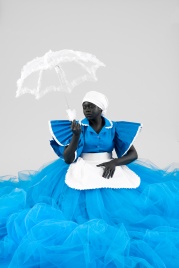
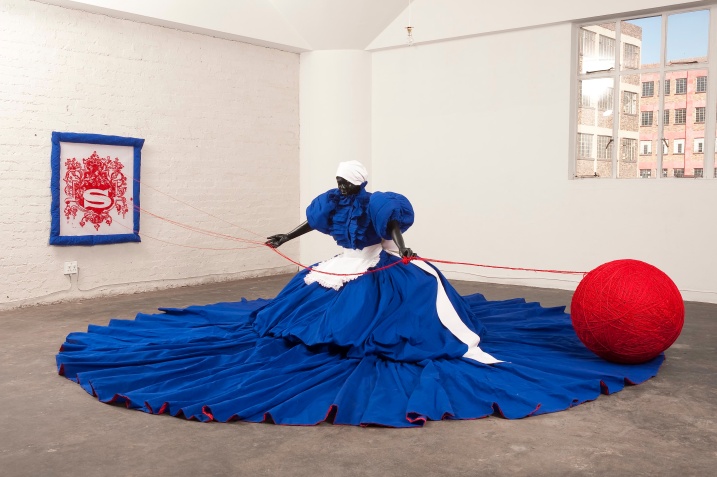
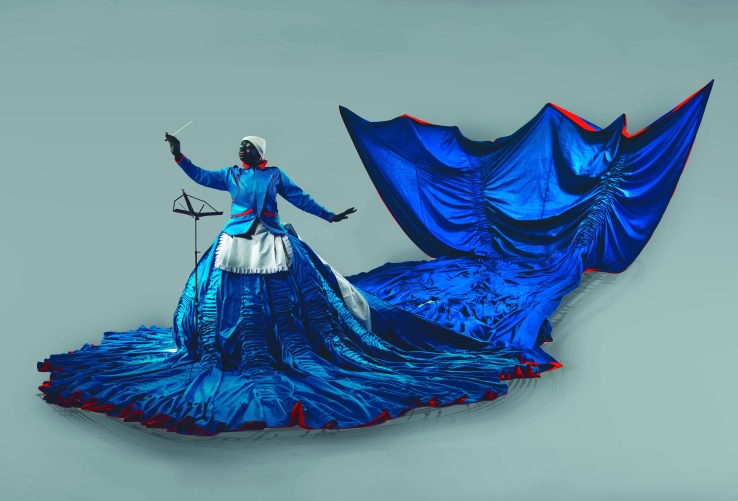
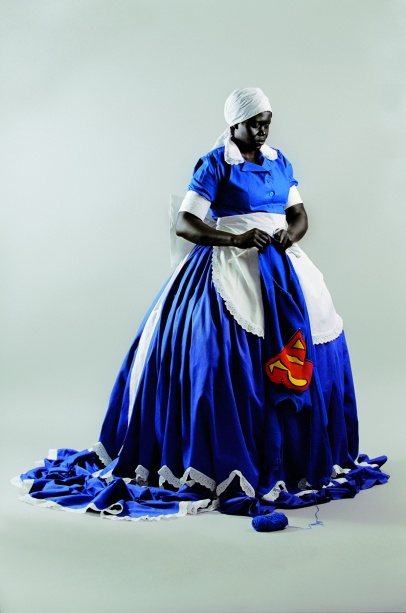
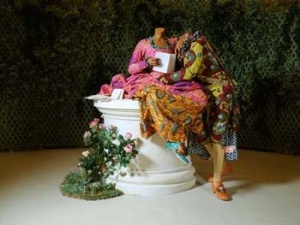
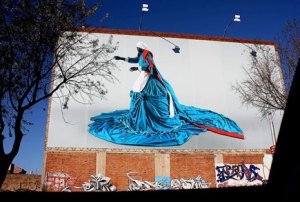
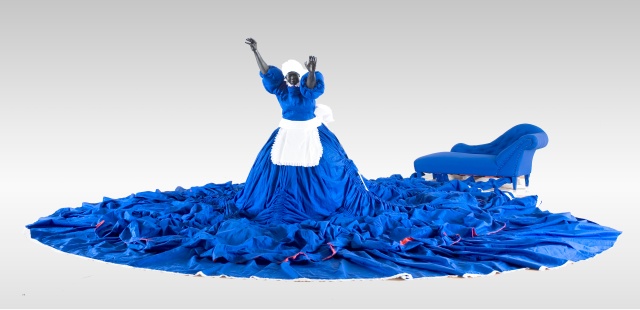
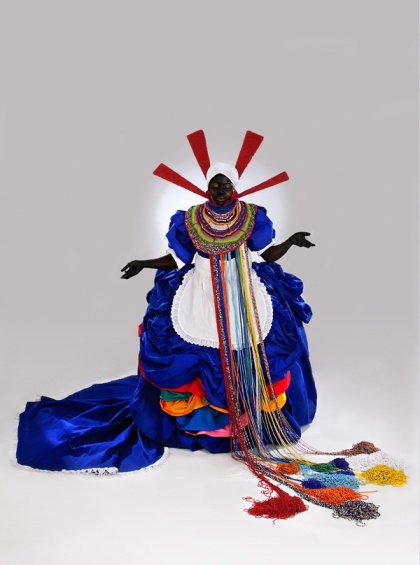
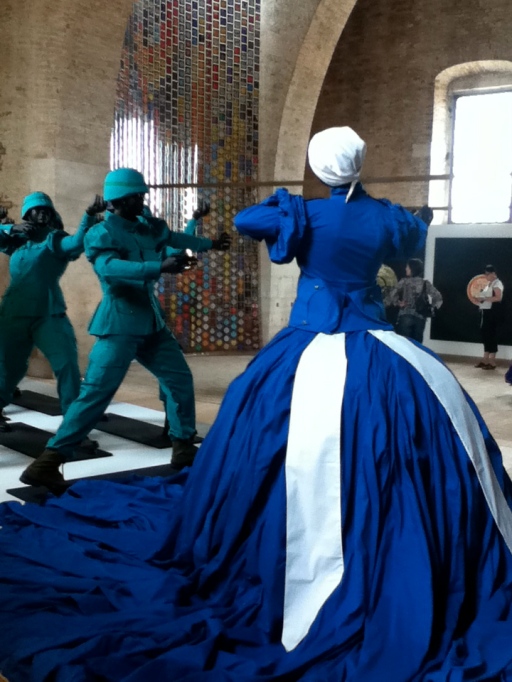
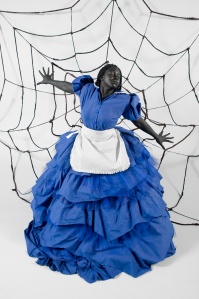
Definitely one of the most exciting South African artists around at the moment..